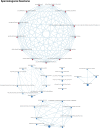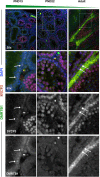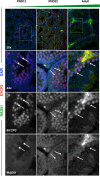Dynamic transcriptome profiles within spermatogonial and spermatocyte populations during postnatal testis maturation revealed by single-cell sequencing
- PMID: 30893341
- PMCID: PMC6443194
- DOI: 10.1371/journal.pgen.1007810
Dynamic transcriptome profiles within spermatogonial and spermatocyte populations during postnatal testis maturation revealed by single-cell sequencing
Abstract
Spermatogenesis is the process by which male gametes are formed from a self-renewing population of spermatogonial stem cells (SSCs) residing in the testis. SSCs represent less than 1% of the total testicular cell population in adults, but must achieve a stable balance between self-renewal and differentiation. Once differentiation has occurred, the newly formed and highly proliferative spermatogonia must then enter the meiotic program in which DNA content is doubled, then halved twice to create haploid gametes. While much is known about the critical cellular processes that take place during the specialized cell division that is meiosis, much less is known about how the spermatocytes in the "first-wave" in juveniles compare to those that contribute to long-term, "steady-state" spermatogenesis in adults. Given the strictly-defined developmental process of spermatogenesis, this study explored the transcriptional profiles of developmental cell stages during testis maturation. Using a combination of comprehensive germ cell sampling with high-resolution, single-cell-mRNA-sequencing, we have generated a reference dataset of germ cell gene expression. We show that discrete developmental stages of spermatogenesis possess significant differences in the transcriptional profiles from neonates compared to juveniles and adults. Importantly, these gene expression dynamics are also reflected at the protein level in their respective cell types. We also show differential utilization of many biological pathways with age in both spermatogonia and spermatocytes, demonstrating significantly different underlying gene regulatory programs in these cell types over the course of testis development and spermatogenic waves. This dataset represents the first unbiased sampling of spermatogonia and spermatocytes during testis maturation, at high-resolution, single-cell depth. Not only does this analysis reveal previously unknown transcriptional dynamics of a highly transitional cell population, it has also begun to reveal critical differences in biological pathway utilization in developing spermatogonia and spermatocytes, including response to DNA damage and double-strand breaks.
Conflict of interest statement
The authors have declared that no competing interests exist.
Figures













Similar articles
-
Single-Cell RNA Sequencing of the Cynomolgus Macaque Testis Reveals Conserved Transcriptional Profiles during Mammalian Spermatogenesis.Dev Cell. 2020 Aug 24;54(4):548-566.e7. doi: 10.1016/j.devcel.2020.07.018. Epub 2020 Aug 13. Dev Cell. 2020. PMID: 32795394
-
Riding the spermatogenic wave: profiling gene expression within neonatal germ and sertoli cells during a synchronized initial wave of spermatogenesis in mice.Biol Reprod. 2014 May;90(5):108. doi: 10.1095/biolreprod.114.118034. Epub 2014 Apr 9. Biol Reprod. 2014. PMID: 24719255 Free PMC article.
-
Surfing the wave, cycle, life history, and genes/proteins expressed by testicular germ cells. Part 1: background to spermatogenesis, spermatogonia, and spermatocytes.Microsc Res Tech. 2010 Apr;73(4):241-78. doi: 10.1002/jemt.20783. Microsc Res Tech. 2010. PMID: 19941293 Review.
-
The Mammalian Spermatogenesis Single-Cell Transcriptome, from Spermatogonial Stem Cells to Spermatids.Cell Rep. 2018 Nov 6;25(6):1650-1667.e8. doi: 10.1016/j.celrep.2018.10.026. Cell Rep. 2018. PMID: 30404016 Free PMC article.
-
Molecular regulation of spermatogonial stem cell renewal and differentiation.Reproduction. 2019 Nov;158(5):R169-R187. doi: 10.1530/REP-18-0476. Reproduction. 2019. PMID: 31247585 Review.
Cited by
-
Transcriptome Profiling of the Ovarian Cells at the Single-Cell Resolution in Adult Asian Seabass.Front Cell Dev Biol. 2021 Mar 29;9:647892. doi: 10.3389/fcell.2021.647892. eCollection 2021. Front Cell Dev Biol. 2021. PMID: 33855024 Free PMC article.
-
The germ cell-specific RNA binding protein RBM46 is essential for spermatogonial differentiation in mice.PLoS Genet. 2022 Sep 21;18(9):e1010416. doi: 10.1371/journal.pgen.1010416. eCollection 2022 Sep. PLoS Genet. 2022. PMID: 36129965 Free PMC article.
-
The Regulation of Spermatogonial Stem Cells in an Adult Testis by Glial Cell Line-Derived Neurotrophic Factor.Front Endocrinol (Lausanne). 2022 Jun 3;13:896390. doi: 10.3389/fendo.2022.896390. eCollection 2022. Front Endocrinol (Lausanne). 2022. PMID: 35721702 Free PMC article. Review.
-
ZFP541 and KCTD19 regulate chromatin organization and transcription programs for male meiotic progression.Cell Prolif. 2024 Apr;57(4):e13567. doi: 10.1111/cpr.13567. Epub 2023 Nov 3. Cell Prolif. 2024. PMID: 37921559 Free PMC article.
-
Global characterization of mouse testis O-glycoproteome landscape during spermatogenesis.Nat Commun. 2025 Mar 18;16(1):2676. doi: 10.1038/s41467-025-57980-7. Nat Commun. 2025. PMID: 40102425 Free PMC article.
References
-
- Lawson KA, Hage WJ. Germline development. Ciba Foundation Symposium 182. Wiley; 1994.
Publication types
MeSH terms
Grants and funding
LinkOut - more resources
Full Text Sources
Molecular Biology Databases

